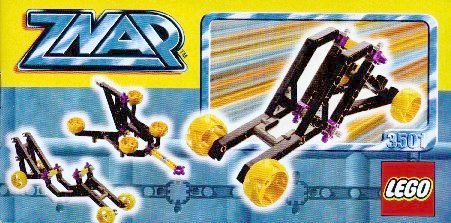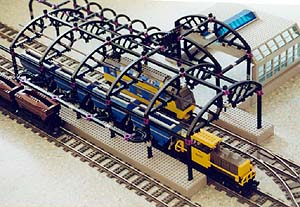

In 1998 I was fortunate to visit LEGO Futura, the product development headquarters of The LEGO Group, in Billund Denmark. I was there for introductions and to be briefed for a freelance design job which I would work on from home.
There was plenty opportunity to wander around the design departments and see design studies, concepts and newly developed products. At some point, I noticed an extensive display of intricate plastic structures in many shapes and forms, which I didn't recognize to be anything LEGO.
- 'So', I asked the friendly Dane who showed me around, 'what on earth is THAT!?'
- 'That, my friend, is our K'nex killer'.
The K'Nex construction toy had taken the market by storm. It's inventor had sold the idea to the biggest toy company around, so in no-time it was heavily marketed, widely available and persistently succesful in stores around the globe. The LEGO Group devised a counter-attack with no small measures. An entire new product line was developed.

The 1999 new product line had its own brand name, ZNAP, besides the familiar LEGO logo. The name must be invented as 'Snap, with a twist'. Which it literally was. The pieces snapped together, most easily while twisted.
In the Dutch language, the name was peculiar to say the least. It sounded like 'Is nep', meaning 'Is fake'. Which it was, in the sense that it was not the 'real' K'nex. This is the first way in which the ZNAP venture can be considered a low: it tried to imitate the competition, thereby implying the other brand was the real thing.
While in general appeal the ZNAP system was designed to resemble K'NEX, it actually didn't mimic it up close. Ofcourse for legal reasons it could not, but anyway, LEGO designers did a very good job of coming up with an alternative, original, clever connection system. So in its own right, the ZNAP building system had its virtues.




The models didn't look very appealing as display models, but once you handled the parts and experienced the ease and flexibility of construction, you could understand, physically feel, the appeal of both ZNAP and K'nex. The ZNAP connectors were clever and effective. You could simply break the pieces apart, or rotate for 'transforming' the shape of the structure. Special flexible axles were designed, so a motor could drive the wheels of a car, even while you casually transform the shape of the car.

ZNAP shapes can work out well in some structures.
Compatibility with regular LEGO building bricks was limited however, and the audience didn't percieve it as what they expect to be 'LEGO'. Consumer interest was reasonable at first, but as a temporal fad only. After its second year, the entire product line was discontinued. For LEGO enthusiasts it was a great time to buy cheap electric motors in marked-down ZNAP sets. Meanwhile, K'nex stayed around.
While cleverly designed, I mainly consider ZNAP a failure because The LEGO group could have invested this huge amount of money, time and talent into strengthening and improving their core product, which is the brick based building system. Widening the system should better be done gradually from the core out, instead of designing a seperate system with some adapters and connecters for compatibility.
Rumour has it, that ZNAP wasn't the failure we think it was. The LEGO Group may have had satisfying returns on investment during its short life cycle. And a rumour said that this adventure forced K'nex to sell the company, maybe even to The LEGO Group (which officially is not the case). So perhaps the ZNAP line was discontinued because it had served its purpose well.

Otherdam junction, my 'compatibility study' of ZNAP.
Discuss at LUGnet
Set pictures: www.brickset.com
Part pictures: www.peeron.com